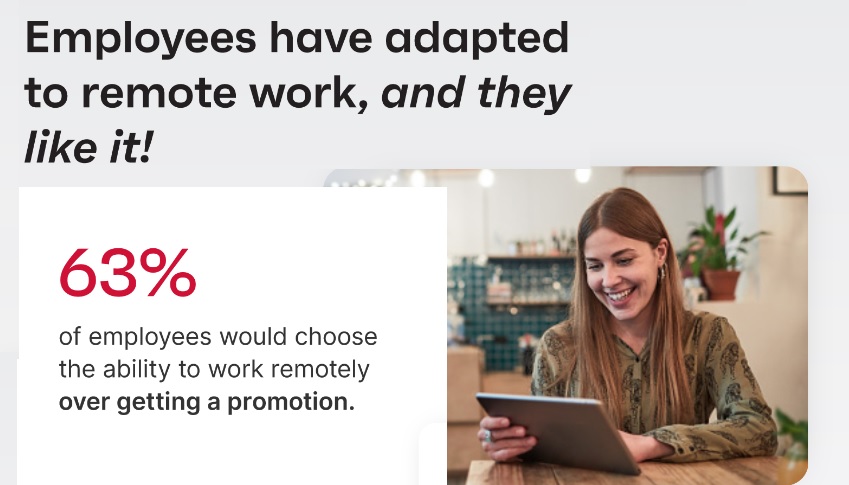
Your employees aren't coming back to the office, at least not in the traditional sense. The pandemic shifted almost all industries into remote work.
As a result, employees had to adapt to a new routine that included home life and work life in the same environment, forcing them to strike a balance between their personal and professional lives and embrace greater flexibility in their schedules. Despite a vaccine rollout well underway, the safety of returning to the office isn't garnering much enthusiasm from employees. And according to the results of Ivanti's Everywhere Workplace survey, they're not interested in going back to the way things once were.
Choosing Flexibility Over Career Security
According to the survey, nearly two-thirds (63%) of respondents said they would rather work remotely than be promoted, and almost half (48%) would take a pay cut in exchange for working from anywhere. This enhanced desire for remote and hybrid work models even extends beyond giving up new opportunities in one's career — some would give up their jobs altogether. For example, a recent Bloomberg survey /a> found that 39% of employees said they would quit their jobs if their employers weren't flexible with remote work.

The survey results indicate that employees are experiencing significant improvements in their personal lives due to their new work dynamics. What seemed like a hard transition one year ago has become an overwhelming success.
In fact, respondents listed flexible work schedules (47%), less commute stress (43%), and better work-life balance (35%) as the top benefits of remote work. These newfound perks are benefits that employees want to keep long after the pandemic.
Over one-third (37%) of respondents said they would still prefer to work from home if given a choice after the pandemic and another third (38%), said they prefer a hybrid work model — the best of both worlds perhaps?
That said, embracing a fully remote or hybrid workforce has benefits that extend far beyond your employees' personal needs, and this approach can be a vital tool in recruitment and employee retention while improving an organization's overall security protocols.
How a Remote Workforce Impacts Your Bottom Line
By embracing the Everywhere Workplace, businesses can appease the needs of their employees while setting themselves up for success when recruiting and retaining prospects. Although this can be for several reasons, the work-from-everywhere model allows organizations to recruit talent from anywhere, eliminating the limitations of only searching for employees who live within commuting distance and diversifying their culture — an important yet attractive initiative that promotes creativity and teamwork.
As a result, organizations that embrace the Everywhere Workplace can widen their selection of potential talent while at the same time rest assured knowing that their offerings are most appealing to the modern workforce.
The survey also found 37% of respondents traveled to a location away from home and set up shop to work during the pandemic, and 21% moved to a new city or state — meaning companies that embrace the remote office for good provides a competitive edge against other organizations seeking similar talent.
That said, while employees have warmly received the shift to the Everywhere Workplace, this transition can threaten an organization's overall security and therefore requires a variety of changes to security protocols.
For starters, most organizations this past year started modernizing their IT help desks to provide immediate assistance to employees no matter where they're located. An upgrade that at one time was considered a nice-to-have quickly evolved to become a top priority as tech teams were stretched thin and inundated with responses.
Nearly one quarter (22%) of employees surveyed contacted IT support one to three times per month for various tech issues, including password resets, Wi-Fi issues, and the inability to access corporate resources. All of which can cause interruption to a remote employee's workflow — as well as countless new opportunities for breaches.
However, by implementing a zero trust security strategy, organizations can discover, manage and secure devices while delivering optimal personalized experiences for their users. With a remote, dispersed workforce, companies are at higher risk. To reduce this risk, companies should ensure every potential access point to mission-critical information and systems is from an authenticated user and secure device, regardless of where employees log in.
The New Era of the Home/Office
While many organizations have since adapted to remote work by force, the "new normal" will require organizations to adapt to the needs of employees who favor remote work by choice. Luckily, by implementing a multi-layered zero trust security strategy, organizations can better adapt to employee desires for distributed office setups while simultaneously improving the overall security policies and cyber hygiene.
What's more, this approach can include implementing key security features like passwordless authentication and automated verification of secure networks, helping companies achieve constant threat detection while providing a simplified and positive user experience for their employees.
The modern workforce demands flexibility. Luckily, by embracing zero trust security tactics to enable the Everywhere Workplace, organizations will be slated to improve employee happiness while improving their overall security as a whole. With only a few adjustments, companies will be prepared to thrive in their "new normal."
Lastly, one piece of advice: the survey also found that one in five remote employees have taken a video conference while not wearing pants. So always think twice before asking a remote employee to stand up during a meeting.
